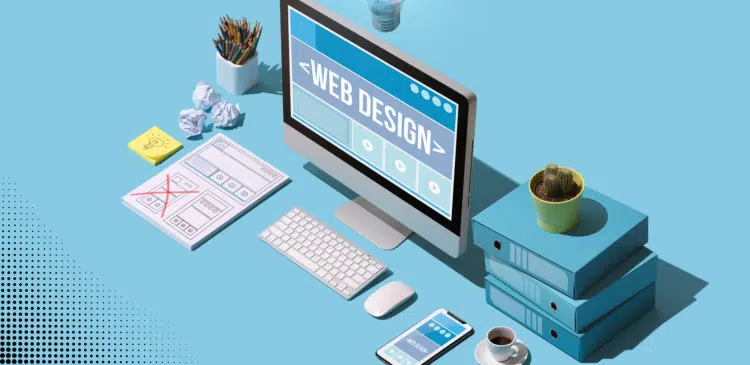25+ Facts about Web Design You Need to Know in 2023

Welcome to fast-paced web design! In the digital world, a beautiful, user-friendly website is essential. Understanding web design is essential for business owners trying to expand online and aspiring web designers looking to stay ahead.
But where to begin? We’ll cover you! This blog post will introduce 25+ amazing web design facts you need to know in 2023. Consider this your comprehensive guide to its unique history, designs, and future.
The History of Web Design
In the early 1990s, the internet was young. Websites were basic text with a few graphics. They were the days! However, web design advanced rapidly with technology.
HTML gave web designers additional tools to create visually appealing web pages. Instantly, tables and frames became popular for page organization. It was like discovering new possibilities!
As CSS emerged in the late 1990s, designers could separate style from structure. This discovery made consistency across numerous pages easier and unleashed creativity like never before.
The birth of responsive design may have been the most significant web design milestone. Websites have to adapt to numerous screen sizes as smartphones and tablets take over our lives. Responsive design transformed the user experience by optimizing viewing on all devices.
Minimalist designs are popular today. Clean lines, abundant white space, and bold typography make modern websites that grab readers’ attention immediately.
The evolution of web design since its humble beginnings shows that it’s always changing! Brace yourself—web designers worldwide are in for thrilling times.
The Different Types of Web Design
Web designers use different methods. Each variety has unique benefits and features for different needs and tastes.
Minimalist web design is popular. Simple lines and lots of white space give this style a modern appeal. For maximum effect, it uses bold text and limited color palettes.
Mobile devices popularized the flat design. Simple two-dimensional elements without gradients or shadows are used. The flat design aims for a consistent user experience across screens.
Google introduced material design. It simulates actual materials with a flat design and realistic shadows and motions. The material design creates depth and hierarchy while looking tidy.
Illustrative web design encourages innovation. This method uses bespoke graphics to enhance storytelling or give personality to the website. Illustrations can make the user experience more playful.
Grid-based web designs organize content into well-defined grids or columns. This structure balances and unites the layout while making website navigation easier.
Parallax scrolling is another popular web design technique. Background graphics move at varying speeds when visitors scroll down the page with parallel scrolling, producing a 3D illusion that enhances storytelling or highlights products/services.
There are several site designs accessible today, although each project may require a distinct blend based on goals and target audience preferences.
The Pros and Cons of Web Design
Web design has perks and downsides. First, the pros. Web design gives businesses and people a strong online presence. Well-designed websites attract visitors, generate leads, and convert.
Another benefit of web design is flexibility. With a custom website, you can customize the user experience for your brand and audience. Interactive components, attractive images, and straightforward navigation can improve the user’s trip.
Web design enhances branding. Your audience may understand your brand values and message through thoughtful color schemes, fonts, graphics, and content placement.
Web design includes drawbacks like any other undertaking. Professional web design services or in-house designers might be expensive. Quality site design involves time and talent, which can be costly.
If you don’t know coding or CMS, maintaining a website can take time. Security and keeping up with technology and consumer expectations require regular updates.
Finally, poorly built websites may not accommodate those with disabilities or impairments that affect their online interactions.
Web design has several benefits, including creating an online presence with visually appealing designs that match your brand.
What is Responsive Web Design?
Modern website construction requires responsive design. It involves making websites that alter their look, information, and functionality dependent on the device being used. So, responsive web design makes your site appear fantastic and work smoothly on desktops, tablets, and smartphones.
Why does responsive web design matter? Mobile gadgets have made internet access on small screens more common than ever. If your website isn’t optimized for these devices, potential clients may leave due to poor navigation or delayed loading times.
User experience is improved with responsive web design. By making sure your site appears fantastic on all devices, you can provide visitors a smooth browsing experience that keeps them coming back.
Responsive web design boosts SEO. Search engines like Google rank mobile-friendly websites higher because they know people need relevant results on any device.
Besides being user- and SEO-friendly, responsive site design is cost-effective. By investing in one flexible website, you avoid the need to create and maintain distinct versions for desktop and mobile devices.
Responsive web design keeps up with the digital age where consumers want seamless experiences across platforms. This technique should be your first concern whether developing a new website or redesigning an existing one if you want your business to prosper online in 2023 and beyond.
How to Choose the Right Web Designer
Selecting the appropriate web designer is essential to building your business’s online presence. Making the right choice might be difficult with so many possibilities. Here are some important web designer selection variables.
Experience and knowledge come first. An experienced web designer will have a portfolio to demonstrate their style and skills. You need someone who knows your industry and audience.
Communication is crucial when choosing a web designer. You want someone who listens to your ideas, goals, and needs and offers competent advice. Clear communication keeps both sides on the same page during design.
Consider other designers’ services. Some specialize in e-commerce or responsive design, while others offer more services.
Consider budget when assessing candidates. Cost shouldn’t be the only concern, but you should balance quality and affordability within your budget.
Consider client testimonials. This feedback might reveal how satisfied others were with a site designer.
The Future of Web Design
Web design is looking brighter than ever in 2023 and beyond. With technology and user behavior changes, websites are adapting to modern consumers’ needs.
The mobile-first design will likely grow. Designers must focus on mobile optimization since most internet consumers browse websites on smartphones. This requires responsive designs that work across screen sizes and resolutions.
AI will also influence web design. Many websites offer AI-powered chatbots for rapid service and better user experiences. AI algorithms will increasingly personalize website content based on user choices and behavior in the coming years.
With VR growing in popularity across industries, web designers are researching ways to incorporate VR into online experiences. Imagine visiting a virtual store or a tour from home! VR in site design could change how we engage with online material.
Smart speakers are making voice search more popular, therefore optimizing websites for voice inquiries is crucial. Web content and navigation designers must address natural language processing.
Minimalism is expected to dominate online design aesthetics. Clean layouts with lots of white space make websites seem good and improve usability by decreasing clutter.
As global internet speeds rise, designers will have more multimedia integration freedom. Future websites will feature seamless video backdrops, interactive animations, and immersive music.
Conclusion
Web design has evolved each year since its inception. We covered web design’s history, types, benefits and cons, responsive design, finding the appropriate web designer, and even the future in this essay.
Web design is vital to our digital world, from simple HTML pages to large interactive websites and apps. It is essential to create user-friendly experiences that engage visitors and boost commerce.
Web design evolves with technology at an unparalleled rate. In 2023 and beyond, AR, VR, voice-powered interfaces, and other revolutionary trends are expected.
However, “the only constant is change.” New gadgets like smartphones, smartwatches, and IoT-connected appliances are released often, so web designers must stay current to keep their designs accessible across platforms.
Additionally, “user experience” will remain key to web design. Designing sensible layouts with easy navigation and attractive aesthetics will be the focus.



 Bill Yeager, Co-Owner of High Point SEO & Marketing in CT
Bill Yeager, Co-Owner of High Point SEO & Marketing in CT